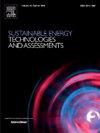Assessing the viability of solar-biogas hybrid systems for energy provision in rural Kenyan communities
IF 7.1
2区 工程技术
Q1 ENERGY & FUELS
Sustainable Energy Technologies and Assessments
Pub Date : 2025-02-22
DOI:10.1016/j.seta.2025.104244
引用次数: 0
Abstract
This study evaluated the viability of a hybrid solar photovoltaic (PV)-biogas system with the goal of resolving the ongoing lack of energy access in rural communities with a focus on Kenya’s Kesses region, Uasin Gishu county. The study aims to assess energy demand, economic and environmental impacts, evaluate resource potential, model a hybrid system and gather data from 100 households. An estimated 780 kg of firewood per day is needed, with maize residues and cattle manure having biogas potentials of 88.08 and 309.7 m3/day, respectively against minimum requirement of 141.8 m3/day. The electrical demand is 114.75 kWh/day. The best setup which makes use of HOMER, includes an 18.20 kW converter, a 25.50 kW PV module, a 143-kWh battery capacity, and a 3-kW biogas generator. The Net Present Cost (NPC) and levelized Cost of Energy (LCOE) come to USD 183,558 and 0.171$/kWh, respectively. Additionally, findings showed that switching to biogas for cooking reduce CO2 emissions by 60,193.39 kg annually. Sensitivity analysis indicates that the costs of biogas generators have no effect on NPC and LCOE, while a greater inflation rate shows a double effect. PV-Biogas hybrid systems present a viable way to electrify rural areas and household’s livelihood improvement.
评估太阳能沼气混合系统在肯尼亚农村社区提供能源的可行性
本研究评估了太阳能光伏-沼气混合系统的可行性,目的是解决农村社区持续缺乏能源的问题,重点是肯尼亚乌辛吉舒县的凯塞斯地区。该研究旨在评估能源需求、经济和环境影响,评估资源潜力,建立混合系统模型,并收集 100 户家庭的数据。估计每天需要 780 公斤木柴,玉米秸秆和牛粪的沼气潜力分别为 88.08 立方米/天和 309.7 立方米/天,而最低需求量为 141.8 立方米/天。电力需求为 114.75 千瓦时/天。使用 HOMER 的最佳设置包括一个 18.20 千瓦的变流器、一个 25.50 千瓦的光伏组件、一个 143 千瓦时的电池容量和一个 3 千瓦的沼气发电机。净现值成本(NPC)和平准化能源成本(LCOE)分别为 183 558 美元和 0.171 美元/千瓦时。此外,研究结果表明,改用沼气做饭每年可减少 60,193.39 千克二氧化碳排放量。敏感性分析表明,沼气发电机的成本对 NPC 和 LCOE 没有影响,而更高的通货膨胀率则会产生双重影响。光伏-沼气混合系统为农村地区电气化和改善家庭生活提供了一条可行的途径。
本文章由计算机程序翻译,如有差异,请以英文原文为准。
求助全文
约1分钟内获得全文
求助全文
来源期刊

Sustainable Energy Technologies and Assessments
Energy-Renewable Energy, Sustainability and the Environment
CiteScore
12.70
自引率
12.50%
发文量
1091
期刊介绍:
Encouraging a transition to a sustainable energy future is imperative for our world. Technologies that enable this shift in various sectors like transportation, heating, and power systems are of utmost importance. Sustainable Energy Technologies and Assessments welcomes papers focusing on a range of aspects and levels of technological advancements in energy generation and utilization. The aim is to reduce the negative environmental impact associated with energy production and consumption, spanning from laboratory experiments to real-world applications in the commercial sector.
 求助内容:
求助内容: 应助结果提醒方式:
应助结果提醒方式:


